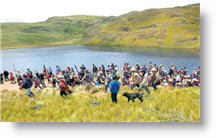 Yanacocha has suspended its $4.8 billion Conga gold mine project in Cajamarca, as protests by regional leaders and peasant farming communities have continued to build up.
Yanacocha has suspended its $4.8 billion Conga gold mine project in Cajamarca, as protests by regional leaders and peasant farming communities have continued to build up.
In a joint press conference at the government palace with Prime Minister Salomon Lerner Ghitis, the senior vice-president for South America of Newmont-Yanacocha, Carlos Santa Cruz, said the company’s decision aimed to improve a climate of dialogue and consensus between the differing opinions.
“We have the best of intentions” of improving the project and the company’s systems of communication with the communities, Santa Cruz said.
Lerner said that the government had asked Yanacocha to consider the importance of water in the life of communities over gold.
Yesterday, some 20 people protesting the project in Cajamarca region were injured during a clash with police on the sixth day of demonstrations, Ideeleradio reported. Days earlier, protestors had raided the Conga mine offices and other Yanacocha installations, damaging property and setting one building ablaze.
The confrontation with police occurred close to the Azul Lake, when some 1,000 protesters were turned back by police with tear gas, the report said.
The Conga gold and copper project is an open-pit project that lies above 3,500 masl in the southeast highlands of Cajamarca, being developed by Yanacocha, the largest gold producer in Latin America and owned by US-based Newmont Mining and Peru’s Cia. De Minas Buenaventura. It’s proven probable reserves in 2006 were of 11.8 million ounces of gold and 3.2 billion pounds of copper, which would give an estimated mine-life of 19 years.
To reach the mineral, the project requires the draining of four lakes into artificial reservoirs. The lakes are the Azul, Perol, Mala and Chica.
Residents are calling for the project to be cancelled, citing concerns that it will lead to environmental pollution.
Officials in President Ollanta Humala’s government reviewed the project’s environmental impact study, approved in October 2010 during President Alan Garcia’s administration.
The Ministry of Energy and Mines review was favorable but a report by the Environment Ministry, which was leaked to IDL Reporteros, found “grave environmental objections” in the study, wrote IDL director and veteran journalist, Gustavo Gorritti.
Energy and Mines minister Carlos Herrera was critical of the report and called it “alarmist.”
On Monday, Jose de Echave, the deputy minister of environmental management, resigned from his post and criticized how the government has managed the protests.
In an interview with Ideeleradio on Tuesday, De Echave rejected Herrera’s claim that the report was alarmist and said it was put together by 20 experts. “There are a number of analysts who try to misinform,” De Echave said.
“The report could be too technical, but what we are pointing out is that the hydrobiological study has some things missing that should be completed,” De Echave said.
On Sunday, Environment minister Ricardo Giesecke tried to put out some of the fires by giving interviews on leading news analysis TV shows to explain his ministry’s report.
“The environmental impact of the project will be irreversible, yes, but that is not necessarily bad when there are benefits for everyone concerned,” Giesecke told Enrique Castillo of Canal N’s ADN Politico program. “There is always room for improvement, for perfecting a project,” he added, and indicated as an example the need, in the draining of the lakes and building of dams, to include systems that will ensure the farming communities in the watershed of each lake continue to have access to their water supplies.





